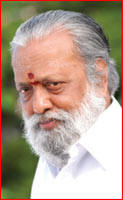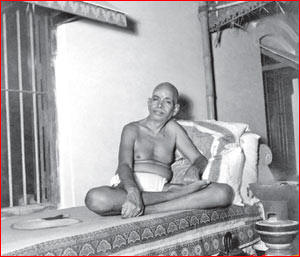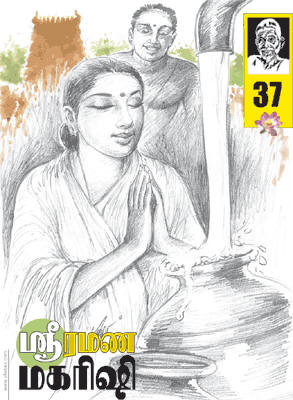Sakthi Vikatan 2011-09-06
SriRamana Maharishi
Curing his disease and having initiated Self-realization in him and not
calling him a Guru: By what other name you call him? From darkness to
the light he took a devotee: What would you call him other than a Guru?
Ramasamy Iyer with melting heart wrote many poems. Whenever he
found time, Ramasamy Iyer came to Tiruvannamalai for Darśan of Bhagavan
and a few days of stay with him. When he was in Orissa in public
service, he developed blisters on the soles of his feet, which caused
him severe pain. “Ramana! I
surrender unto you…You are my refuge,” Iyer wrote a song.
-
Next day a few devotees came from Tiruvannamalai at the behest of Bhagavan to see Ramasamy Iyer before they go on the
 pilgrimage to Kāsi.
When they noticed the suffering from the blisters, they
smeared an ointment on his feet, leaving the remainder with him. The
next day the blisters subsided.
pilgrimage to Kāsi.
When they noticed the suffering from the blisters, they
smeared an ointment on his feet, leaving the remainder with him. The
next day the blisters subsided.
There is no distance between a Guru and his disciple. As the disciple
thinks of him in his mind, the Guru will appear. He will render help for
sure. “You (Ramasamy Iyer) told us a story that your salary of 150 rupees goes to
waste as judged and pronounced by the supervisor. If you get 200 rupees, what will
he say?” A rise to Rs. 200 salary happened.
Guru helps his disciple normalizing his ill health, removing his mental
problems, mitigating his financial burden, taking him from darkness to
light and helping him delve deep into his Self.
Just this alone! Not so. There is more.
Guru removes domestic problems.
The daughter of P.K. Sundaram Iyer lived in an apartment complex in
Lucknow with her husband.
The water did not rise to her 3rd floor apartment. Her
husband hand-carried the water up to the 3rd floor. She did
not have the strength and endurance to carry water to her third-floor
apartment. It was pathetic to look at their misery.

Unable to bear the suffering of her husband, she was upset. They did
not know how to solve this water problem. She sang the poem written by
Ramasamy Iyer sitting before the water pipe. As she sang with
a concentrated mind, a blast of air exited the pipe followed by torrential
water flow. She filled all the pots with water.
The husband wondered how it happened. She admitted that singing the
Śaranāgati poems with thoughts of Ramanar helped bring water to the
water pipe. The husband asked her to sing the songs again with the
result the water flowed from the pipe. Singing other songs did not
result in water flow. When she mentioned this episode in Virūpākṣi cave,
all the disciples believed her without any reservation.
Ramasamy Iyer famous for his Śaranāgati poems had a daughter, who
showed her drawing of Varalakshmi to Bhagavan, who asked, “Why should we
not get it printed?” She borrowed money here and there, got the drawing
printed and distributed them to many people. That child knew Srīramaṇar
was like a God. Bhagavan helped Ramasamy Iyer more than once: He cured
him of his illness; he solved his financial problems; He took care of
mental distress; He helped him attain self-realization; Bhagavan helped
his children too. Bhagavan’s nature was to embrace the family of those
who surrendered to him.
Must we talk to Mahāns for explication of Tattvas and attaining lofty
purpose in life? Do we attain maturity from
conversations with Mahāns for the pursuit of Self? There is nothing
like that. Raghavachari employed by the Govt. in a high position sat
before Bhagavan with three questions. He sat silent, though he had the
questions in his mind.
Once he sat before Bhagavan intending to receive answers to the
questions. “Is it possible
to meet with you alone for a few minutes?
What does Bhagavan think of Theosophical Society?
If I am a deserving person, would you show me your real form?
“These were his questions lurking in his mind. The assembled people
dispersed for one reason or another. The occasion rose for Bhagavan and
Raghavachary face each other alone. “What is the book you have in your
hand? Are you a member of the society? That society is doing a good
job.” All these words from Bhagavan without one word out of the mouth of
Raghavachary. Two questions
were answered with no prompting. Should not an answer to the 3rd
question become available? Raghavachay stared at the eyes of Bhagavan
with the thought of an answer to the third question in the mind: What is
your true form?
Then, Bhagavan was sitting on a raised platform with his back agaisnt
the wall.
There was an image of Dhakshinamurthy hanging from the wall.
Both Bhagavan and the image were easily seen, when facing
Bhagavan. As he looked at him intently, there was an internal change.
Bhagavan disappeared from the sight of Raghavachary. The wall
disappeared. There was only a vast space. Then a blinding light
appeared. Bhagavan and the Dhakshinamurthy in his image appeared bright.
It was so bright, Raghavachary closed his eyes. After a while, he left
Bhagavan’s presence with a salutation to the mountain and went home. He
did not meet with Bhagavan for about a month. That divine sight left an
indelible impression on his mind. Fearing loss of that imprint (of the
sight), he did not meet Bhagavan again. He gathered courage and went to
Bhagavan for Darśan. He told him with humility, “I asked you certain
things. I received what I asked for.”
 He
narrated to Bhagavan about the disappearance of Bhagavan, the open
space, and the gradual appearance of Bhagavan and Dhakshinamurthy in his
vision. He queried him, “What is this?” Bhagavan said, “You desired to
see my real form. I am formless. You are a reader of Bhagavadgita.
Because of its impetus on you, Dhakshinamurthy and I appeared as
effulgent light in your vision. You ask Ganapathy Muni about this.”
Raghavachary did not wish to explore further. The previous wonderful
epiphany gave him fulfilment. Guru’s mercy was great.
With no conversation and debate, and with tranquility, Bhagavan
drew Raghavachary to his divine Self, demonstrated to him who he was and explicated
later the vision. Guru’s Sannidhi is where your wishes and wants are
fulfilled.
He
narrated to Bhagavan about the disappearance of Bhagavan, the open
space, and the gradual appearance of Bhagavan and Dhakshinamurthy in his
vision. He queried him, “What is this?” Bhagavan said, “You desired to
see my real form. I am formless. You are a reader of Bhagavadgita.
Because of its impetus on you, Dhakshinamurthy and I appeared as
effulgent light in your vision. You ask Ganapathy Muni about this.”
Raghavachary did not wish to explore further. The previous wonderful
epiphany gave him fulfilment. Guru’s mercy was great.
With no conversation and debate, and with tranquility, Bhagavan
drew Raghavachary to his divine Self, demonstrated to him who he was and explicated
later the vision. Guru’s Sannidhi is where your wishes and wants are
fulfilled.
Some office workers visit with Bhagavan for Darśan during their
lunch-break. Some devotees gave up their jobs and surrendered to
Bhagavan.
Ayyasamy from South Africa, who worked under the Europeans making a good
living, surrendered to Bhagavan with his wealth. Though he was flush
with cash, he went down the mountain and begged for food. On their
begging rounds for food, the devotees sang songs to the householders.
But, Ayyasamy did not know songs.
A woman in one household asked Ayyasamy to sing Sivapuranam. Ayyasamy
not knowing, was on tenterhooks.
The woman herself sang Sivapuranam and served him food. He was ashamed.
He learnt Sivapuranam studiously. Bhagavan said in humor, “Why does
Ayyasamy go on begging rounds? Is there some wealth he lacks?
Though he had money, he had the maturity in the spirit of asceticism to
go begging for food. He was taking the right path. Ayyasamy was
dexterous with his hands. He could fashion walking sticks from the tree
limbs. He could fashion a polished bowl out of half coconut shells,
which he gave to the Sadhus. His work made him happy. He stayed with
Bhagavan for 10 years with no opposition from the rest, went back to his
village and died. Better than what he gained as riches in South Africa
is the great gains he made in Bhagavan’s Sannidhi.
Guru does not talk about himself in a self-laudatory aggrandizement to others.
But the disciples of Guru talk. His disciples told the world the life
and times of Bhagavan. The breeze that touched and embraced the flowers talks about
(carries) the fragrance and yet the flowers remain silent. That
fragrance makes the seeker look for the spiritual flower.
Let us get Darśan.
